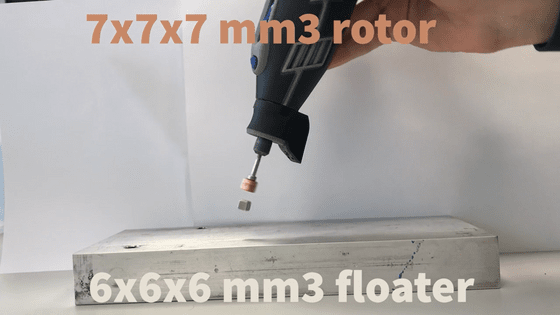The secret of the mysterious phenomenon that when a high-speed rotating magnet is brought close to another magnet, the magnet rotates and levitates is revealed.

When two magnets are placed facing each other with the same poles, they repel each other, and if you place one magnet under the other, it is possible to make one magnet float. However, simply arranging the magnets creates an unstable balance, making it difficult to maintain the floating magnets. Therefore, there are effects such as
Symmetry | Free Full-Text | Polarity Free Magnetic Repulsion and Magnetic Bound State
https://www.mdpi.com/2073-8994/13/3/442

Physics - How Rotation Drives Magnetic Levitation
Phys. Rev. Applied 20, 044036 (2023) - Magnetic levitation by rotation
https://journals.aps.org/prapplied/abstract/10.1103/PhysRevApplied.20.044036
Systems that use magnetism to levitate objects, such as maglev trains , magnetic bearings , and flywheels , generally use a 'feedback mechanism' to stabilize the magnetic field. In addition, toys such as Levitron and U-CAS utilize a mechanism in which a top made of a magnet is rotated on a magnetic plate, causing the top to levitate due to the gyroscopic effect .
Mr. Hamdi Youker conducted a new experiment on magnetic levitation. The following is a post by X that introduces Mr. Uker's experiment.
By rotating a permanent magnet at high speed, another permanent magnet can be rotated and levitated https://t.co/X8HWNXqzMA
— Kazuyoshi Yukimasa (@Kyukimasa) October 17, 2023
It is a new phenomenon of magnetic levitation that was discovered two years ago, and the theory behind stable floating had not been explored until now.
It is different from Levitron (gyro effect of magnetic levitation toy U-CAS) and completely different from superconducting pinning.pic.twitter.com/7SaI8n1FFA
First, Mr. Uker attached a magnet to the tip of the rotor, a tool that rotates at high speed, so that the axis between the magnet's N and S poles was perpendicular to the motor's rotation axis.

Also, another magnet called a 'floater' was placed on top of the base.

Mr. Uker turns on the rotor, rotates the magnet, and brings the rotor close to the top of the floater.

Then, the floater spun and floated up into the air a few centimeters away from the magnet at the tip of the rotor.

Furthermore, Mr. Uker moves the rotor to various angles, but the floater does not fall off and follows the movement of the magnet at the tip of the rotor.

When Mr. Uker turned off the power to the rotor, the floating floater fell down.

Since the announcement of Mr. Uker's experiment, many scientists have conducted research on ``why the floater rotates stably,'' but they were unable to identify the mechanism.
However, a research team led by Rasmus Björk of the Technical University of Denmark designed an environment that could be used for experiments at home using commercially available neodymium magnets, adhesives, and power tools. The research team attached a spherical magnet with a diameter of about 19 mm to the rotor and varied the rotation speed from 7,500 to 17,000 rpm.
The floaters used various spherical magnets with diameters ranging from 5 to 30 mm, and the research team used recording devices and motion tracking software to measure the movement of the levitated rotor. 'Our experiment is so simple that it can be done at home,' Björk said.

As a result of the measurements, the research team said, ``Once the floater starts rotating, it synchronizes with the magnets attached to the rotor and is able to float stably.'' ``Although the floater was slightly tilted a few degrees, it was able to float stably.'' The rotational axis of the south pole was oriented perpendicular to the rotor's magnets.'' ``This arrangement, where the axis of the pole is almost perpendicular, would normally result in instability, but in this experiment it floated stably.'' is reported.
In addition, regarding the fact that the axis of the pole, which is normally unstable, points vertically, the research team says, ``The rotating magnetic field generated by the rotor applies torque and rotational force to the floater, and as a result, a gyroscopic effect works, causing the axis of the pole to become vertical. We speculate that the force applied to the floater changes due to changes in the magnetic field as the rotor rotates, causing it to levitate on its own.
``The electricity required to move the rotor is very small, so it is unlikely to have had an effect on the floater's levitation,'' Uker said. By performing simulations that take into account

Marcel Schuck, CEO of the technology company No-Touch Robotics , said, ``The system in which the magnet rotates is simpler than the conventional system that actively controls magnetic levitation, and it is also simpler than the system that uses an induced current mechanism.'' It is thought that there is little energy loss.This system has the potential to be applied to magnetic field trapping of atoms and manipulation of magnetic force.''
Related Posts:







